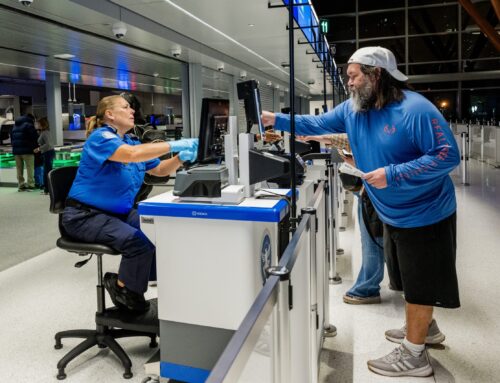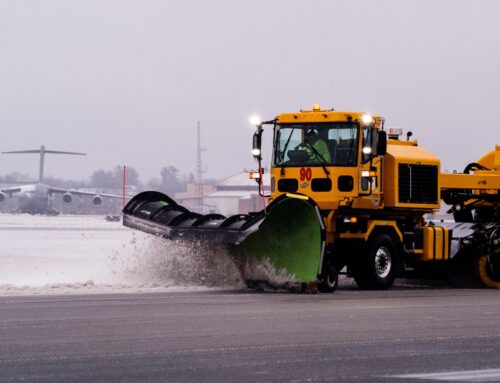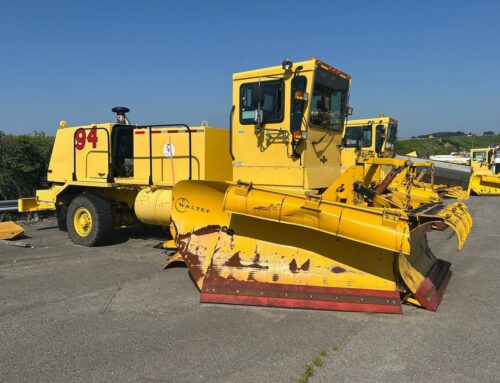COVID Signs Add to Airports’ Wayfinding Journey
Signs, digital monitors, visual cues keep travelers safe—and help them find their way
By Jesse Geleynse
Published October 12, 2020
Read Time: 4 mins
In September, when Adam and Courtney deVries entered Seattle-Tacoma International Airport to catch a flight to Pittsburgh, they were greeted by a sign asking them to remain a moose antler’s length apart from other travelers as a social-distancing measure.
“It’s fun to see the creative ways companies tell you to stay six feet apart,” said Adam deVries, noting that another sign used an eagle’s wingspan to make the point.
The COVID-19 pandemic has not only changed airports’ cleaning and sanitization protocols; it has also required new custom signs and decals, like SeaTac’s social-distancing messages inspired by local wildlife, to keep travelers safe. In Pittsburgh, the six feet social distancing markers note that’s the height of PNC Park’s left field fence, the width of 24 pierogis and, well, the Steelers have six Super Bowl wins.
“I definitely noticed a lot more hand sanitizer, lots of signs about social distancing and masks, and announcements over the loudspeakers regarding those things,” added Courtney deVries.
But while the deVrieses have traveled extensively and are familiar with SeaTac, the additional signage adds to what can already be an overwhelming visual experience for less-experienced travelers.
What is wayfinding?
For people who fly infrequently, making their way through unfamiliar, sprawling airports plastered with advertisements, commercial logos, LED screens, temporary signs and more can be intimidating and even a bit scary.
Airports try to alleviate those concerns through wayfinding, the process by which people plan, navigate and execute a route. At airports, that includes both digital and static signage, universal pictograms and the architecture itself—something Samantha Stedford, customer experience director at Pittsburgh International Airport, refers to as “intuitive wayfinding.”
“We have spaces where it’s very open, and where it will converge and be a little more constricted,” Stedford said. “That’s where it’s supposed to visually cue passengers about where to go next, along with different colors and patterns and textures on the floor.”
As a mid-size airport, PIT is relatively easy for most passengers to navigate, but wayfinding can be a far more challenging task at some of the nation’s largest airports.

Digital signs rotate messages related to the COVID-19 pandemic and new health protocols at Chicago O’Hare International Airport. (Photo by Matt Neistein)
At Hartsfield-Jackson Atlanta International Airport, which saw more than 110 million passengers last year, the staff utilizes overhead banners, social-distancing floor clings and strategically placed guest relations personnel to help make the process as seamless as possible, according to Jai Ferrell, assistant general manager of commercial development at ATL.
“Digital signage is also a really great way because it’s versatile and we can change and pivot at the drop of a hat in case we need to make any quick shifts or anything like that while individuals are traveling throughout the day,” Ferrell said.
Avoiding clutter
At Dallas-Fort Worth International Airport, which saw more than 75 million passengers in 2019, the staff seeks to strike the right balance between necessary information and signage that can overwhelm. Too much visual clutter is a disservice, said assistant vice president of customer programs Megan Bozarth.
“There are different types of stress levels, and perhaps in the pandemic, even more than ever,” Bozarth said. “So it’s a balance of being informative (and) intuitive, but then not inundating them with too much information.”
DFW begins its COVID messaging in the parking garages and reemphasizes the mask and social-distancing messages in places with less of the airport’s traditional wayfinding signage.
“We don’t use a lot of floor graphics for wayfinding, for example, but you can use floor graphics for social distancing,” Bozarth said. “It is a balance, but we are really thinking in terms of the customer perspective—where they might see a particular message or where they might be in the travel process to be able to communicate.”
Likewise, ATL has utilized colored floor placards to reinforce social distancing.
“We’ve simplified the branding so it’s a little bit different from our traditional wayfinding,” Farrell said. “It sticks out a little bit more for individuals who have come through our airport more often.”
It remains to be seen how the COVID pandemic will permanently affect the passenger experience, even as airports continually seek ways to improve their wayfinding infrastructure.
But there is one aspect of COVID signage the deVrieses found compelling: the floor clings.
“If we’d taken our (2 1/2-year-old) daughter (to Pittsburgh), she would have loved stopping and standing on every single one,” Adam deVries said. “She’s done that in other places without the six-foot thing, and she would have had a great time. It’s very good for small children and can help keep them occupied.”
Tips for travelers
Airport officials offer this advice for traveling in the age of COVID:
Check the website: Airport websites are updated frequently to help passengers plan for their journeys. PIT’s website features TSA wait times and parking lot capacity reports to help travelers avoid congregating at gates.
“We keep (our website) up to date with the most current information so you can find all the latest policies and regulations there,” Stedford said.
Bring food: Not only are most airlines no longer serving food, but some airport restaurants are operating at reduced hours.
“Fortunately, (PIT) had a QR code to tell you what was open, and that was very helpful,” Courtney deVries said.
Look for the badge: There’s no shame in asking for help if you find yourself overwhelmed, so check in with guest services.
“The reality is, that human touchpoint is still very important,” ATL’s Farrell said. “Feel free to reach out to any of our guest services agents or anyone that can support you on site wearing a badge. We still have our (personal protective equipment), we’re still wearing our masks, but we’re still able to help you wayfind.”






